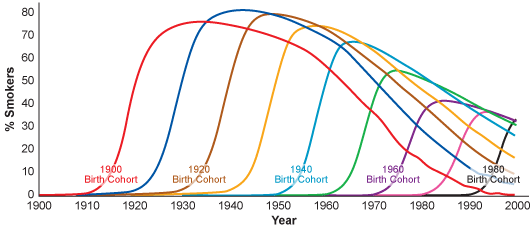Multi-cohort Simulation
This type of modeling captures a range of birth cohorts and the changing risk factor profiles, screening behaviors, and treatments used by each cohort as it ages. It allows us to represent the impact of interventions in the actual U.S. population. Recent developments have shown that multi-cohort cost-effectiveness models have advantages over single hypothetical cohorts representing the actual population dynamics over time.
Smoking Prevalence by Birth Cohort

Reconstruction of smoking histories of the U.S. white male population for people born between 1900 and 1980 combining data across National Health Interview Surveys (NHIS). The highest percentage of smokers among the white male U.S. population was in 1943 for the birth cohort 1910 (men aged 33 years).
"Results of CISNET's modeling show that it is important to think carefully about which population will be affected by screening or other health policies; modeling only a part of the relevant population can have a major impact on the cost-effectiveness estimates."